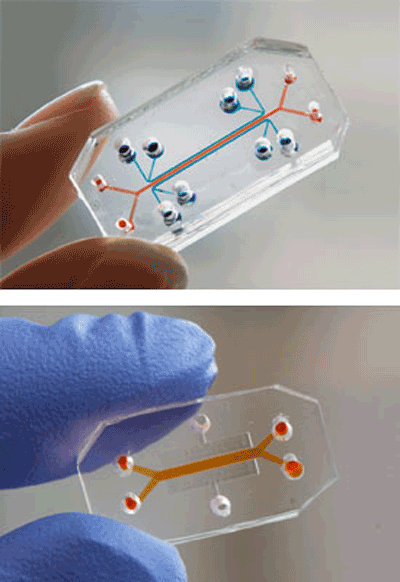Imagine a human organ. Now imagine that human organ on a chip the size of a computer memory stick. The Wyss Institute for Biologically Inspired Engineering at Harvard University has entered into an agreement with the Defense Advanced Research Projects Agency (DARPA) that will grant them $37 million to develop an automated instrument integrating 10 human organs-on-chips.
The Wyss Institute has already made advancements in this field within the past few years. They have developed a lung, kidney, “gut,” and bone marrow on chips. Now they will discover a way to link the individual organs into a functioning microsystem.

The device will mimic the human body and provide real-time analysis of biochemical functions. (Image via Wyss.harvard.edu)
Since each microdevice is translucent, it allows researchers to study the internal functions of organs without actually diving into a human body.
The microchip is composed of clear flexible polymer and contains channels lined by living cells. For example, the lung-on-a-chip is clear and flexible. It is lined by lung and capillary cells. It also contains vacuum channels on the outer sides. The porous sheet in the center of the chip, as well as the cells, expand and release rhythmically, just as our living cells do when we breath.
The air flows over the top of the human lung cells on the chip, while a liquid containing human white blood cells flows below the capillary cell layer.
The video below will give you a deeper look into how a lung-on-a-chip actually operates.
Why create organs on chips?
Pharmaceutical companies that test their medications on animals are not receiving results that reflect actual human responses. As a result of using a device such as this, they can more accurately predict the results of drugs. Animal also prove to be more expensive and time consuming. This human-on-a-chip is also simple to use so biologists, physicians, chemists, and others with no engineering background can benefit from its development.
The FDA will be working in conjunction with the Wyss Institute to develop a model of this human-on-a-chip that will help protect Americans from chemical, biological, radiological, and nuclear threats, as well as infectious diseases by decreasing the amount of testing time on drugs.
Check out the video below to learn more about the human-on-a-chip technology. ■
Story Via: Wyss Institute
Advertisement
Learn more about Electronic Products Magazine





